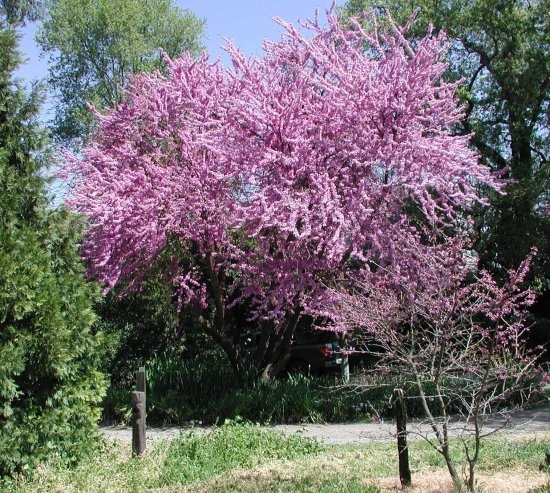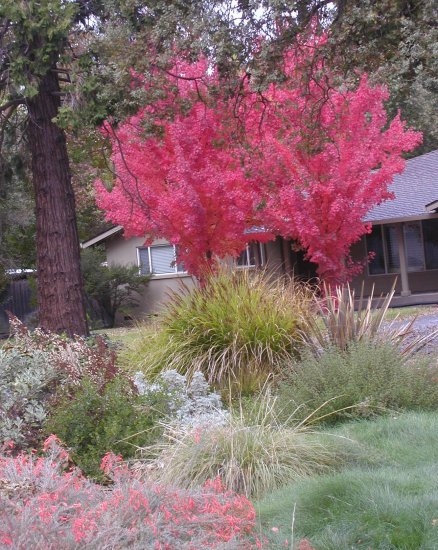A friend asked me recently if there are modest sized trees to plant for shade. Her recent experience was removing a Magnolia tree which had cracked up her driveway. The back-hoe operator, who took out the root-ball, said it was the largest he had ever removed. We have to be wary of planting trees that grow too large for their space or so large that they are very expensive to remove them when their expiration date comes around and all living things do have an expiration date. Recently, I removed three large, old evergreen conifers from the backyard of my new home to make room and sunshine for growing dahlias and vegetables. It was costly and made me aware that planting trees that grow to a large size can be a financial loser.
When it comes to planting the right size tree and a beautiful one there is a tree that fills the bill and that is Autumn Blaze Maple. It is a patented hybrid of red and silver maples. Whereas red maple (Acer rubrum) is a large tree to 120 feet in nature, the hybrid ‘Autumn Blaze' (Acer x freemanii ‘Jeffersred'), has a maximum height of 50 ft. It has brilliant eye catching red color, dense branching and rapid growth. It is fast growing, disease resistant, tolerates a wide range of soil conditions, doesn't drop seed pods and is resistant to car exhaust pollution.
Another red maple cultivar is Acer rubrum ‘columnare'. It grows in a more column like manner, elliptical in form but spreading more in maturity. There is a beautiful pair of red maple trees across the street from my home and I think they have the ‘columnar' appearance. Unfortunately, they were planted a bit too close to the house, but the current owner didn't plant them and when he discovered how attractive they are in the fall, he decided not to remove them. For more information on Red Maples, click here.
When it comes to selecting smaller trees that work for areas under power lines, PG&E has a list of recommended trees that are under 25 feet for you. You can find more about this and order a brochure from this website .
One smaller tree that will not exceed 25 feet is crepe myrtle (Lagerstroemia indica). There are a variety of cultivars and the National Arboretum has released over 24 hybrids selected for cold hardiness, resistance to powdery mildew and other pests, and for varying heights, vigor, habits, flower colors, fall foliage colors, and bark characteristics. All U.S. National Arboretum cultivars have Native American names. Powdery mildew commonly infects older varieties.
Acer palmatum ‘Bloodgood' is a good small tree for the Central Valley as it handles heat better than some Japanese maples. It will do better if afforded some afternoon shade, but it can handle full sun. It needs moist soil, so is not a drought tolerant variety, but will appreciate mulching to conserve moisture. Its maximum height and spread is about 20 ft.
Easter Redbud (Cercis canadensis) is a beauty when it blooms in the spring. My country home was named Redbud Farm because the original owner had planted several redbuds on the property and they are now very mature trees. They bloom a gorgeous pink for about 3 weeks in the spring before leafing out and they attain a height of about 30 feet and 20 feet wide. Monrovia has a cultivar of the Eastern Redbud that is better adapted to the southwest named ‘Mexicana' and for other small trees, click here. The Western Redbud (Cercis occidentalis) is a native and more drought tolerant than its 
Pineapple guava (Feijoa sellowiana) is an evergreen tree of 15 ft. height and as wide with edible flowers and edible fruit. They are deer resistant, if you live in deer country, and seem to be generally pest-proof. Once established they are drought tolerant and although self-fruitful, I have never had any fruit on my solitary tree so better to plant more than one if you want the fruit. They can tolerate some shade and require only light pruning to shape them. They make a good screen plant and can be pruned into a hedge though not recommended.
Whatever tree you plant, may it be beautiful, small and tidy.
If you have a gardening related question you can contact the UC Master Gardeners at 209-953-6112. More information can be found on our website: http://sjmastergardeners.ucanr.edu/CONTACT_US/